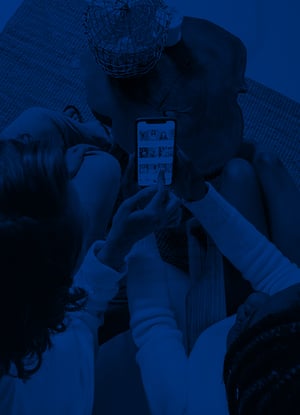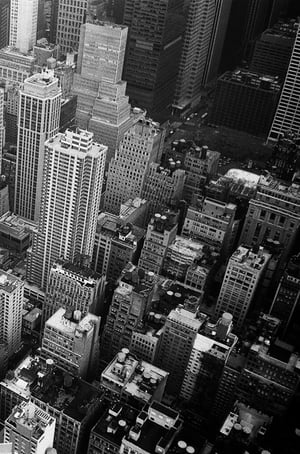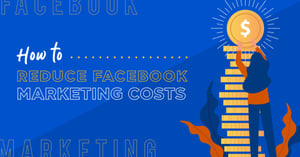Reducing Facebook advertising costs for every brand and or industry comes down to a few main tenants.
1. How well you've targeted your audience.
2. The ad quality of your creative.
3. And a frictionless path to purchase or lead generation.
It may interest you to note that the more precise you can be on the above the lower your advertising cost. The greater the reach, the higher the click-through, and more sales and leads are a natural function of this.
So whether you are doing this in-house or with an agency, you should remain focused on the above. Like all advertising that preceded this, you are not competing with your competitors or your industry. You are competing with anyone vying for the same attention you are.
In 2021, 2022, attention is a scarce commodity! Put another way; there is an oversupply of brands and an undersupply of clients and consumers for those brands.
The be in the top two brands of any market is the ideal position. For most companies; failing this, you want to make sure that you're growing faster than your industry baseline.
If your industry is growing at 5% per year, you need to be growing above that to outperform the market. Otherwise, your average, and based on this, you may even be starting to fall behind the market.
So how do you use Facebook advertising to move ahead of your market and outgrow your industry? I'm glad you asked.
How to Spend Less on Facebook ads to Grow Your Business.
Depending on your experience with Facebook advertising, and the associated costs, you might find this surprising.
Facebook will provide you with enough guidance in terms of advertising to reduce your advertising costs. Any agency that's managing this proactively will share this data with you so that you can both improve your ad campaign objectives.
The below is an insight into this guidance and how Facebook ranks your ad performance.
- Quality Ranking: This is a ranking of your ads' perceived quality. Your ad is ranked against post-click experience and the other ads competing against for the same audience.
- Engagement Ranking - in this area, your ad is ranked based on the engagement in the Facebook feed in terms of clicks, likes, comments and shares.
- Conversion Rate Ranking: Lastly, this area assesses how likely your audience is to convert based on the experience.
Your goal here is to try and score above average in every respect. Facebook will provide you with the percentage ranking if you're below average and tell you where you are falling short. For example, if you're below average, you might be in the bottom 35% of those competing against the same audience.
You use this guidance to modify your ad and experience and identify the area where you might be weakest. It will help you improve your advertising and reduce your costs while increasing your conversions.
You are encouraging Facebook to show your ad to a broader audience.
You Have Competition
The title says it all, but there's no doubt that you have competition. But to put this into context, there are now more than 7,000,000 advertisers on Facebook.
You compete with every advertiser on Facebook, but you're also competing with their friends' content, family's content, and any general-interest they might have.
Understanding your exact persona, industry, and pain points are critical to any successful advertising campaign.
Some might disagree with the following statement. But your brand is not for everyone, and even a brand that is, is not! Not everyone buys an Apple computer, and not everyone drinks Coca Cola, and not everyone drinks the same brand of milk.
Being precise about how you are targeting, their pain points, and how you solve for this will help you increase your leads, lower the cost of conversion and improve the quality of your ad.
How does the Facebook Ads Auction Work?
Unlike Google PPC, where you get charged at cost per click (CPC) with the Facebook auction system, you get charged for impressions. The number of people seeing your ad.
The best way to think about this is the same as someone seeing a billboard. The Facebook algorithm decides on the best ads to run based on the maximum paid and ad performance.
As you would expect, all the ads on Facebook are compared with each other. As mentioned above, the system determines that the ad is most likely to succeed within the auction environment and get the ad space.
What are the most significant factors that directly affect Ad Costs?
They are four main factors that are going to affect your advertising costs when it comes to Facebook. And one hidden variable.
Timing
Like any social media advertising platform, when you run your ads is very relevant. The month, part of the year, day of the week or the times within a day can all affect your advertising cost.
Referring to my earlier point of knowing your persona can make sure that you're optimising your ad for specific times.
Facebook's algorithm will do an excellent job of helping you identify the right time to advertise. You should also be reviewing Google Analytics to see when you're getting the most visitors through to your website and or conversions.
Marrying this up with the timing of your advertising can result in more conversions and, of course, more sales at a lower cost.
Bid Strategy – Ad Budget
There are several ways to set up your bid strategy within Facebook. One of the metrics that we've found the most successful is campaign budget optimisation (CBO).
This means we place a budget against the campaign we are running and let the algorithm test for the best performance and time across many ads.
The algorithm will optimise the best performing ads and spend your budget according to that.
Ad Placement
Depending on your business, you might choose to optimise placement to certain parts within the Facebook ecosystem.
You might decide that Instagram is where you want to advertise or choose to advertise across all of Facebook.
We have found both to be successful when it comes to reducing your cost. But please let me explain this further.
If you choose to advertise on Instagram, only this may cost you more. But for some clients, what we found is the conversions increase. The overall ROI is better.
For other clients, what we found is using automatic placement is ideal.
There is always a testing phase that you go through with any new client or any new campaign.
Identifying the correct placement is as important as determining the right timing.
Quality metrics
I want to labour this point much because we covered it above. The quality metrics of your advertising as measured by:
1. Engagement ranking
2. Conversion ranking
3. And quality ranking will factor into the cost of your advertising.
Audience
How competitive is your audience? Is it an audience that everyone is going after, or if you narrow your persona so well that you are outplaying the competition? Your Audience size matters.
We would, of course, recommend the latter, identifying your actual persona. Tailoring your content to that specific persona is where you're going to get the most leverage across your budget.
Conversion
A new offering that Facebook has introduced is the ability to connect your CRM environment.
You are connecting your CRM from a conversion point of view.
If you are a business to business organisation, you can identify what a quality lead looks like and feed that data back to Facebook.
By doing so, you provide the platform with more data. And the algorithm will start to model what your ideal client looks like. Increasing the quality of your leads, which lowers your cost, and improves your ROI.
Is the Cost of Facebook Ads Worth it?
There are now 17 million Australians using Facebook every single month. Not only is Facebook usually cheaper than the other advertising platforms, but it also has the best targeting engine of any platform.
The only platform that we would suggest can rival Facebook is that of Google. The main difference between the two is:
1. Google uses data for its targeting purposes
2. While Facebook targets people and their known behaviours.
If you're targeting people in Australia or anywhere in the world, testing and optimising on Facebook will be worth it.
There, of course, would be a trial period where you identify exactly how to target your key market. But from that point on, you will consistently see a return on your advertising.
How much money should I spend on Facebook ads?
When it comes to Facebook advertising, we recommend having at least a minimum daily budget of $100 a day if you want to test for performance.
We typically work with clients that spend approximately $5000 a month, up to $200,000 a month.
But budget to one side; it comes down to your particular targeting offering and the persona that you're going after.
You can, of course, test for far less than this, but Facebook has a learning stage in their advertising. This learning stage is often influenced by the number of leads or sales, influenced by the budget.
If you go below $100 a day, your advertising may not leave the learning phase because it will not have enough conversion data to work with.
Of course, you can be successful at less than this, but this would be our guide if you use the ad manager yourself.
Why You Should Consider the Return on Investment (ROI), Not Only Cost?
While many people in the advertising space talk about return on advertising spend or ROAS, we believe you should have a greater focus on ROI.
When you consider your business, there's the cost of acquisition. The cost takes you to acquire a new customer, but then there is also the lifetime value of that customer.
If you have modelled your business with data, it might cost you $100 to acquire a customer, as an example. But it is, of course, what this customer spends in months 2, 3, 4 and 12 months that matters the most.
Understanding your true ROI on advertising enables you to identify the fastest leverage points for growth. While I can't find the specific article, I once read that Amazon had a target cost of acquiring around $35 for each new client.
They would lose money on client acquisition in the first instance, but the lifetime value of their client meant that they were profitable over 12 months. They understood how to model the data as the continued growth attests.
So it is not just what it costs you to acquire the client but the true ROI of client acquisition.
A Full-Funnel Strategy
One of the unique aspects of Facebook you can create a multiphase funnel. From awareness, consideration to conversion.
Facebook enables you to set up a three-stage approach. Targeting a brand new audience based on their engagement with your ad, and then further refine this by engagement with the second ad.
This is referred to as a social media funnel which I've written a more in-depth article on how to create one here.
Facebook enables you to build a social media funnel based on engagement.
As an example, suppose your first ad is a video.
In that case, you can track the time people have spent watching that video. You move them into a second audience for anyone who's watched more than 75% of the video.
You are now targeting an engaged audience. Therefore they're more likely to have some affinity or grow to have some affinity with your brand.
You can then create a third audience who watched more than 75% of the second ad. You could then serve the third video to that audience going for the conversion.
There will be some expense upfront, but the return at the back end justifies this strategic approach.
After all, to grow a brand, you need to raise brand awareness and engagement, and that's where a social media funnel comes into play.
Facebook is Still the Most Popular Social Network.
For all the social media networks in the world, Facebook is still the most popular. Whether you're part of a Facebook group, connected to a friend, or friends on Facebook, the average monthly users continue to grow.
As of September 2021, the average number of monthly users at 2.89 billion. With a reported 1.9 billion daily active users, the average user spending 2 hours and 24 minutes on the platform every day.
This dwarfs the next most popular social media platform, YouTube, with an average time spent on the platform of 40 minutes.
When it comes to social media and digital advertising, data is your north star; and data is your single source of truth. Both in audience identification and platform strategies.
The average cost of advertising on Facebook in 2021
According to WordStream, the average cost per click (average CPC) is $2.40 across all industries.
Depending on the industry you're in, this cost is going to be higher or lower.
What's important in these reports is that they measure cost per click, but they are not calculating cost per lead or cost per conversion (sale).
That, of course, is reflective of your company, industry, and how well you have stitched the above together.
Summary
As we move forward into 2022, your understanding of social media funnels and optimal ad performance strategies is increasingly important.
Every month we become more digitally enabled and focused across every business and industry.
This will not change anytime soon. So the greater understanding you have of all the social networks, the more significant the impact upon your company's performance for the foreseeable future.
Your Facebook ad costs will reflect this understanding.
Since 2013 we've been a performance-driven social media advertising, delivering digital marketing outcomes in Australia, United States, Uk, and the Asia Pacific.
When it comes to social advertising and maximising its performance, we are second to none. You can contact us here for a no-obligation discussion and proposal.
We also have some free content below for you to enjoy. Your audience is waiting!

.jpeg?width=200&height=200&name=pexels-mikhail-nilov-6893349%20(1).jpeg)


.jpeg?width=318&height=135&name=pexels-cottonbro-studio-4065876%20(1).jpeg)






